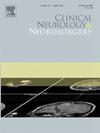重新评估肝素在急性缺血性脑卒中机械性血栓切除术中的作用:风险增加却无功能性益处
IF 1.8
4区 医学
Q3 CLINICAL NEUROLOGY
引用次数: 0
摘要
背景在大血管闭塞(AIS-LVO)导致的急性缺血性卒中的机械取栓术(MT)中可使用肝素,目的是加强再灌注并改善患者预后。方法在PubMed、Embase和Scopus上进行了全面检索,以找到报告AIS-LVO MT期间使用肝素的安全性或有效性的研究。采用随机效应模型进行了 Meta 分析。结果从 2398 条筛选记录中,我们纳入了 15 项研究。接受肝素治疗的患者的良好功能预后率(90 天改良 Rankin 量表 0-2 (mRS 0-2))较低(OR, 0.88 [95 %CI 0.79-0.98]; p=0.023)。接受肝素治疗的患者发生远端栓塞的风险更高(OR,1.25 [95 %CI 1.01-1.55];P=.04)。亚组分析显示,接受静脉溶栓(IVT)的患者发生症状性颅内出血(sICH)的风险较高(OR,2.94 [95 %CI 1.30-6.63];p=.009),mRS 0-2 的比例较低(OR,0.66 [95 %CI 0.50-0.87];p=.004)。总之,我们的分析表明,在 MT 治疗 AIS-LVO 期间使用肝素与较差的临床预后和较高的远端栓塞率相关。此外,它还与接受 IVT 的患者发生 sICH 的风险较高有关。因此,应重新考虑在 MT 期间常规使用肝素。本文章由计算机程序翻译,如有差异,请以英文原文为准。
Reevaluating the role of heparin during mechanical thrombectomy for acute ischemic stroke: Increased risks without functional benefit
Background
Heparin may be administered during mechanical thrombectomy (MT) for acute ischemic stroke due to large vessel occlusions (AIS-LVO), with the aim of enhancing reperfusion and improving patient outcomes. The uncertain balance between risks and benefits of administering heparin during MT prompted us to perform this systematic review and meta-analysis.
Methods
A comprehensive search was conducted in PubMed, Embase, and Scopus to find studies that report the safety or efficacy of administering heparin during MT for AIS-LVO. Meta-analysis was performed using the random effects model. In case of significant heterogeneity a subgroup analysis was performed.
Results
From 2398 screened records, we included 15 studies. Rate of favorable functional outcome (90 day modified Rankin Scale 0–2 (mRS 0–2)) was lower among patients who received heparin (OR, 0.88 [95 %CI 0.79–0.98]; p=.023). Risk of distal embolization was higher in patients who received heparin (OR, 1.25 [95 %CI 1.01–1.55]; p=.04). The subgroup analysis showed that patients who received intravenous thrombolysis (IVT) had higher risk of Symptomatic intracranial hemorrhage (sICH) (OR, 2.94 [95 %CI 1.30–6.63]; p=.009) and lower rate of mRS 0–2 (OR, 0.66 [95 %CI 0.50–0.87]; p=.004). Heparin use didn’t affect successful reperfusion rate (Thrombolysis in cerebral infarction ≥2B), mortality or any ICH risk.
Conclusion
Overall, our analysis indicates that administering heparin during MT for AIS-LVO correlates with worse clinical outcomes and increased distal embolization rates. Moreover, it is linked to a higher risk of sICH in patients who receive IVT. Consequently, the routine utilization of heparin during MT should be reconsidered.
求助全文
通过发布文献求助,成功后即可免费获取论文全文。
去求助
来源期刊

Clinical Neurology and Neurosurgery
医学-临床神经学
CiteScore
3.70
自引率
5.30%
发文量
358
审稿时长
46 days
期刊介绍:
Clinical Neurology and Neurosurgery is devoted to publishing papers and reports on the clinical aspects of neurology and neurosurgery. It is an international forum for papers of high scientific standard that are of interest to Neurologists and Neurosurgeons world-wide.
 求助内容:
求助内容: 应助结果提醒方式:
应助结果提醒方式:


